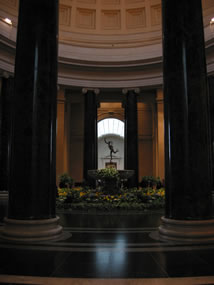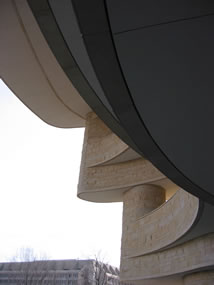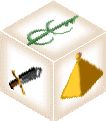Biography
- Final Thoughts |
| In
February, I spent a week in Washington DC on a personal
work retreat. This was a return, of sorts, to my
early architectural roots. It was here [link] that
I formulated the desire to become an architect and
started
down the path of my study of this art. The masthead
picture (above) is the National Gallery of Art. It
impressed me greatly at the time and I thought it
to be one
of
the most
perfectly built buildings in the world. I still
think so. It is executed with a precision one rarely
sees.
This
building is 65 years old [link],
receives heavy use, and still looks new and beautiful
down to the most intimate detail - a tribute to its
design,
construction
and maintenance. Environments like this are not accomplished
by accident. Every time I visit, I think that something
must be right with
a
world
that
can
make, use
and
keep something like this - one thinks of
the concept civilization in the most positive
sense of the word. |
|
| This
is the view from “my desk.” I have been
sitting here drawing and working in my notebooks,
on and off, for over 50 years.
This place never disappoints. It always inspires
contemplation, thought and personal productivity.
This time was
no exception [link].
I spent a pleasant Sunday afternoon and outlined
what I wanted to accomplish on my retreat. This is
a great public space. Peaceful yet with sufficient
movement of people to always keep interest high.
There was a steady flow of people this Sunday. |
| The
space absorbs the crowd with serenity - something
that few buildings can accomplish. It does not overwhelm
- it augments; it frames. The building is
not cold, nor detached. It is “involved” yet
strangely
“untouched” by it
all.
One
can imagine
coming back 50 years from now and seeing this room
just as it is today. If I live to be a 120, I can
do this with a couple of years to spare - a worthy
goal, I think. |
| This
building is a couple of years younger than I am.
We have both witnessed an interesting time of incredible
change - change that is about to accelerate by an
order of magnitude. What constitutes - what makes continuity?
What creates a space of where we have been? In a
world of increasing change, increasing de-materialization,
increasing abstractness, what provides a solid point
of reference - a base line? What provide a common experience
that can be shared by all. This is what public spaces
do. They are social amatures [link]. |
| This
piece is about my “final” thoughts in
regards my biography. I may return to this subject
later in
my life but it is done, except for the filling in
of it (which is still a massive amount of work) -
for now. My journey in architecture started in this
building as much as any place that I can name. It
was here that the idea of a serious life became
present to me. It was here, and playing in the Pentagon,
that
I glimpsed a global reality. It was here that I realized
that the world we live in was made by us; that, there
was an accumulated value largely left untapped. These
were revaluations. Like Taliesin [link],
I have not returned too often. Unlike Taliesin, this
place remains
intact. |
|
 |
Mercury
under the grand dome. I wonder if this is where
I developed my fondness for domes. This is on of
the most timeless spaces I know.
There
is a new comer to the Mall and that is the National
Museum of the American Indian [link].
It
is the first building on the Mall built in the
organic school tradition.
I
compare these two buildings, built 60 plus years
apart, as both architecture and social symbol in
the article Making National Symbols.
link |
|
 |
| There
are few truly public spaces in the United States.
Perhaps we are still too young to be wealthy in this
respect. The Mall in Washington DC is a magnificent
exception to this parsimony. Great public spaces
are not easy to make. There are far more failures
in the attempt than successes. The Mall succeeds.
What factors make this so? It would be good if we
could better understand them. It would be better
if we could build more of them. Our culture needs
this. My ambition is to build a public space that
also is a temple of work and a place of transformation.
I call this project Xanadu [link]. |
| It
is not easy to create a true public life. It
has never been easy. Today is is an even
greater problem than in the past. This is due to
the corroding power of misused media and a body politic
that thrives on sensationalism and controversy. When
I first came to the National Gallery, I was an innocent.
Today, I am no longer an innocent - I am still an
idealist [link].
I am on the threshold of taking a more public role
than in the past. How does one
play
a
public role without being destroyed or corrupted?
What factors make this possible? It would be good
if we could better understand them. It would be better
if more of us could practice them [link]. Our culture
needs this. I have been avoiding this exposure for
years.
Now it has come. I will see if it is possible to
do good and not harm in the exercise of whatever
public
presence that comes my way. |
| We,
our civilization, are entering into the most critical
stage of our existence. For good or ill, a different
political, social,economic order will emerge over
the next 24 years [link]. This will be determined
by the
“problem” we have created for ourselves
- a problem defined equally by what, today, we consider
good
and bad conditions. Our successes in this scenario,
if anything, are even more dangerous than our failures.
All the aspects of this challenge are wired to one
another. This, besides its global scale, is what
makes it complex. Here we are in the dawn of the
21st Century consuming the Earth’s resources
at a rapid rate, our economies growing at a staggering
rate, our nations entering into a period of cultural
wars, our traditional institutions weakened and our
focus decidedly short term and pragmatic. Almost
everyone on Earth is seeking the good life even though
there is no way it can continue to scale and maintain
its present architecture. It is indication of a SYSTEMIC situation
when to do good on one level of the system creates
harm on another level of the system; when
leaders do harm at one part of the system to protect
value at another. |
| What
is required today is a massive re framing of how
we humans typically relate to each other, our institutions
and our planet. We need to take on the task of DESIGNING,
as an emergent system, a planetary culture (with
many healthy diverse cultures) and technical infrastructure
that augments our transformed human life without
destroying other life or our planet as a living thing.
Today,
we are still in the manic phase of growth. We are
emerging from adolescence. We have to mature while
not loosing our creative edge and sense of exploration.
This is but another reason why space is a necessity
[link]. To do this, we have to redefine what a successful
life is. We have to create a method of design and
decision making that brings rigor to the creation
of emergent systems. We have to engage all peoples,
as equals, in the process. We have to take a generation
to create a new civilization. This task has to be
seen as the great crusade that it is [link: a testament]. |
| The
mission of MG Taylor is to create a Method to facilitate
this task and to lay the foundations of an infrastructure
to support the work. The Method exists and has been
tested. The infrastructure of NavCenters is just
beginning to take form. The step ahead, while continuing
to develop both Method and infrastructure, is twofold:
bring the philosophy upon which this work is based
alive in our culture and to build a number of projects/enterprises
that exemplify solutions of a new kind. In a word,
MG Taylor has to apply the tool we have created to
the entire spectrum, education to built examples.
This is the work of the next 25 years. |
| This
requires of me that I take on a new role. This role,
also, has two aspects. One is to practice as an architect
of new enterprises and new environments. The second
is to become a spokesman for a new movement. Both
are challenging; the latter is the greater challenge.
I have said that the creation of one’s own life is
an individual’s greatest creative act. I have worked
diligently to become the person that I am today and
remain a work in progress. The out there, up
front leadership
role has never been my disposition. I have many of
the skills for it (with some notable exceptions),
not the temperament. I have always hoped that someone
to fill this inevitable role would emerge in time.
Our Enterprise is developing in this regard yet the
gap
remains.
It seems that I must fill it - if only for awhile.
The vision of a transforming global infrastructure
has long been my personal passion. At least for awhile,
I must be the one to speak for it. |
|
Matt
Taylor
Washington DC
February 13, 2005
|

SolutionBox
voice of this document:
BUILDING • TACTICAL•
EVALUATE
|
posted
February 13, 2005
revised
April 5, 2005
• 20030213.308799.mt • 20050404.333309.mt •
• 20050505.871209.mt • 20050516.343410.mt •
note:
this document is about 40% finished
me@matttaylor.com
Copyright© Matt
Taylor 2005
|
|
|